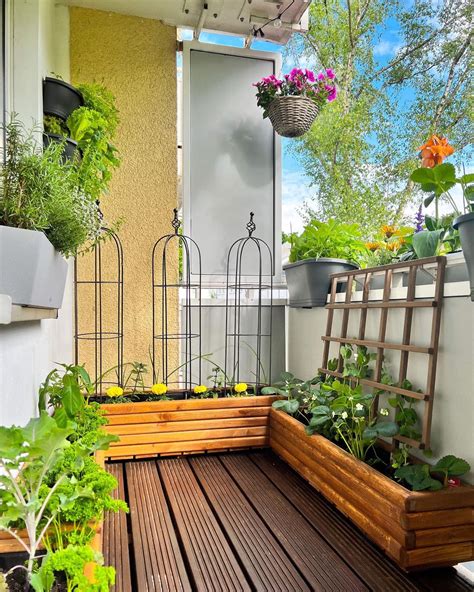Creating a Stunning Themed Balcony Garden: Design Ideas and Practical Tips
Balcony gardens provide an excellent way to transform limited outdoor space into a lush, themed oasis. With careful design, the right selection of plants, and attention to sunlight and growth requirements, you can create a cozy, beautiful area that reflects your personal style. This article covers key considerations, from choosing a theme and layout to practical gardening tips for different types of balconies. Whether you are a beginner or an experienced gardener, this guide will help you get started on your journey to designing a vibrant and functional balcony garden.
Key Concepts in Balcony Garden Design
Themed balcony gardens require thoughtful design decisions. From selecting the right plants to ensuring adequate sunlight and container choices, the overall success of your garden hinges on a few core factors:
- Theme Selection: Choosing a theme that aligns with your style and environment is the first step. Common themes include tropical, Mediterranean, minimalist, and edible gardens.
- Space Utilization: Balconies often have limited space. Vertical gardening, hanging baskets, and multi-layered plant arrangements can help maximize it.
- Container Gardening: The right containers not only influence plant health but also contribute to the visual appeal of the garden.
- Light Requirements: Assess your balcony’s light conditions (full sun, partial shade, or full shade) before choosing plants, as different species have specific sunlight needs.
- Climate Consideration: Balcony gardens are often exposed to wind and temperature fluctuations, so it’s important to choose plants that thrive in your local climate.
Historical Context of Balcony Gardens
Balcony gardening has a long history, dating back to ancient Rome and Greece, where city dwellers used rooftop and balcony spaces to grow herbs and ornamental plants. As urbanization intensified during the Renaissance period, the need for green spaces in densely populated areas led to the expansion of balcony gardening in European cities.
In more recent times, balcony gardens have evolved into a symbol of urban sustainability and personal wellness, particularly in areas where access to larger outdoor spaces is limited. With rising environmental consciousness, many urban residents use balcony gardens to grow organic produce, creating a sustainable connection to nature.
Current State Analysis: Urban Gardening Trends
In today’s cities, balcony gardens are a crucial part of the urban gardening movement, driven by a desire for healthier lifestyles and greener living. From large apartment buildings to small homes, city dwellers increasingly design balcony gardens that reflect their personal tastes while meeting environmental goals such as supporting local biodiversity, using organic gardening methods, and reducing the carbon footprint associated with food transportation.
Innovations like self-watering containers, smart irrigation systems, and compact plant varieties have made balcony gardening more accessible. Moreover, the integration of native plants into balcony designs has become a popular trend, supporting local ecosystems and wildlife.
Practical Applications for Themed Balcony Gardens
Creating a themed balcony garden can be a rewarding process if approached with creativity and planning. Here’s how you can make the most of it:
- Tropical Theme: Incorporate lush, broad-leafed plants such as ferns, palms, and bromeliads. Use bright, colorful containers and hang string lights to mimic a tropical paradise.
- Minimalist Theme: Focus on a clean layout with sleek containers and monochrome colors. Choose sculptural plants like succulents or bonsai trees.
- Mediterranean Theme: Opt for drought-tolerant herbs such as lavender, rosemary, and thyme. Include terracotta containers and a mix of gravel and stones for an authentic look.
- Edible Garden Theme: Grow vegetables, fruits, and herbs. Utilize hanging baskets for strawberries, stackable planters for herbs, and larger pots for tomatoes and peppers.
Case Studies: Successful Balcony Gardens
Case Study 1: Maximizing Space in a Small Balcony
Sarah, a resident of a small urban apartment, designed a vertical herb garden to maximize her limited balcony space. Using wall-mounted planters, she grew mint, basil, and parsley, successfully creating a functional and stylish garden within 20 square feet.
Case Study 2: Mediterranean Oasis in a High-Rise
Mark designed a Mediterranean-themed balcony with drought-resistant plants such as olive trees, lavender, and agave. He used terracotta pots and created a small pebble garden to maintain the theme, transforming his high-rise balcony into a Mediterranean escape.
Stakeholder Analysis
When designing a balcony garden, it is important to consider the different stakeholders involved:
- Residents: Primary stakeholders who will benefit from the garden, experiencing the health and aesthetic advantages.
- Neighbors: Should be considered, especially in terms of how the garden’s visual and environmental impact might affect shared spaces or views.
- Building Management: May have rules regarding balcony modifications, container weight, or the use of water systems, which can affect garden planning.
- Local Wildlife: Urban gardens support local ecosystems by providing habitats for pollinators like bees and butterflies, which should be factored into plant choices.
Implementation Guidelines
Designing a balcony garden requires both creativity and practical know-how. Here are some guidelines for successful implementation:
- Evaluate Balcony Conditions: Assess your balcony’s size, exposure to wind and sunlight, and weight-bearing capacity. This will guide your plant and container choices.
- Start with a Theme: Choose a theme that aligns with your interests, local climate, and space constraints.
- Use Suitable Containers: Choose containers that match the needs of your plants. For example, use deep pots for root vegetables and hanging baskets for cascading plants.
- Prioritize Maintenance: Install drip irrigation systems or use self-watering containers to make maintenance easier.
- Be Creative with Space: Consider vertical gardening options and use multi-level plant stands to optimize space usage.
Ethical Considerations
Ethical gardening involves mindful practices that respect the environment and surrounding community:
- Sustainable Practices: Use organic fertilizers, natural pest control methods, and water-conserving technologies to minimize your environmental footprint.
- Supporting Local Biodiversity: Select native plants or pollinator-friendly species to promote local wildlife and contribute to urban greening.
- Respecting Building Rules: Be mindful of any restrictions imposed by your building management to ensure that your garden does not infringe on others’ spaces or safety standards.
Limitations and Future Research
While balcony gardening offers numerous benefits, it is not without limitations. Space constraints, especially in high-rise buildings, can limit the variety and size of plants. Exposure to wind and weather conditions might also impact plant health. Additionally, certain themes may be more difficult to execute depending on the local climate or available sunlight.
Future research should focus on innovative ways to enhance urban gardening techniques. For example, integrating smart technology such as automated irrigation systems and environmental sensors can make balcony gardens more sustainable and easier to maintain. Additionally, further studies into the psychological and environmental benefits of balcony gardening in densely populated urban areas could reinforce the importance of these green spaces.
Expert Commentary
Experts across the fields of horticulture, design, and urban planning have all emphasized the growing importance of balcony gardens in cities worldwide. Not only do these small green spaces provide aesthetic and personal wellness benefits, but they also contribute to environmental sustainability in urban areas.
According to urban gardening expert Dr. Jane Smith, “Balcony gardens are an essential component of future urban design. They offer a way for individuals to reconnect with nature, even in the densest urban environments, while also supporting biodiversity and helping to mitigate urban heat islands.”
Garden designer and sustainability advocate Alex Johnson adds, “When executed with care, a balcony garden can serve as a miniature ecosystem, supporting local wildlife while also creating a sense of personal sanctuary for the gardener.”


